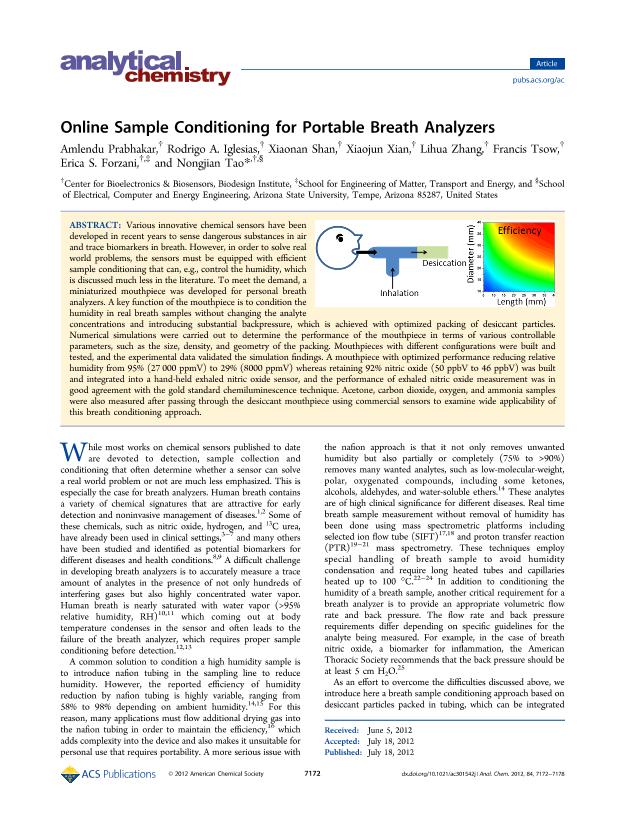Mostrar el registro sencillo del ítem
dc.contributor.author
Prabhakar, Amlendu
dc.contributor.author
Iglesias, Rodrigo Alejandro

dc.contributor.author
Shan, Xiaonan
dc.contributor.author
Xian, Xiaojun
dc.contributor.author
Zhang, Lihua
dc.contributor.author
Tsow, Francis
dc.contributor.author
Forzani, Erica S.
dc.contributor.author
Tao, Nongjian
dc.date.available
2018-10-16T20:01:02Z
dc.date.issued
2012-08
dc.identifier.citation
Prabhakar, Amlendu; Iglesias, Rodrigo Alejandro; Shan, Xiaonan; Xian, Xiaojun; Zhang, Lihua; et al.; Online sample conditioning for portable breath analyzers; American Chemical Society; Analytical Chemistry; 84; 16; 8-2012; 7172-7178
dc.identifier.issn
0003-2700
dc.identifier.uri
http://hdl.handle.net/11336/62481
dc.description.abstract
Various innovative chemical sensors have been developed in recent years to sense dangerous substances in air and trace biomarkers in breath. However, in order to solve real world problems, the sensors must be equipped with efficient sample conditioning that can, e.g., control the humidity, which is discussed much less in the literature. To meet the demand, a miniaturized mouthpiece was developed for personal breath analyzers. A key function of the mouthpiece is to condition the humidity in real breath samples without changing the analyte concentrations and introducing substantial backpressure, which is achieved with optimized packing of desiccant particles. Numerical simulations were carried out to determine the performance of the mouthpiece in terms of various controllable parameters, such as the size, density, and geometry of the packing. Mouthpieces with different configurations were built and tested, and the experimental data validated the simulation findings. A mouthpiece with optimized performance reducing relative humidity from 95% (27 000 ppmV) to 29% (8000 ppmV) whereas retaining 92% nitric oxide (50 ppbV to 46 ppbV) was built and integrated into a hand-held exhaled nitric oxide sensor, and the performance of exhaled nitric oxide measurement was in good agreement with the gold standard chemiluminescence technique. Acetone, carbon dioxide, oxygen, and ammonia samples were also measured after passing through the desiccant mouthpiece using commercial sensors to examine wide applicability of this breath conditioning approach. © 2012 American Chemical Society.
dc.format
application/pdf
dc.language.iso
eng
dc.publisher
American Chemical Society

dc.rights
info:eu-repo/semantics/openAccess
dc.rights.uri
https://creativecommons.org/licenses/by-nc-sa/2.5/ar/
dc.subject
Chemical Sensor
dc.subject
Sample Preparation
dc.subject
Mouthpiece
dc.subject
Breath Analyzer
dc.subject.classification
Otras Ciencias Químicas

dc.subject.classification
Ciencias Químicas

dc.subject.classification
CIENCIAS NATURALES Y EXACTAS

dc.title
Online sample conditioning for portable breath analyzers
dc.type
info:eu-repo/semantics/article
dc.type
info:ar-repo/semantics/artículo
dc.type
info:eu-repo/semantics/publishedVersion
dc.date.updated
2018-09-18T16:16:41Z
dc.journal.volume
84
dc.journal.number
16
dc.journal.pagination
7172-7178
dc.journal.pais
Estados Unidos

dc.journal.ciudad
Washington
dc.description.fil
Fil: Prabhakar, Amlendu. Arizona State University; Estados Unidos
dc.description.fil
Fil: Iglesias, Rodrigo Alejandro. Consejo Nacional de Investigaciones Científicas y Técnicas; Argentina. Arizona State University; Estados Unidos
dc.description.fil
Fil: Shan, Xiaonan. Arizona State University; Estados Unidos
dc.description.fil
Fil: Xian, Xiaojun. Arizona State University; Estados Unidos
dc.description.fil
Fil: Zhang, Lihua. Arizona State University; Estados Unidos
dc.description.fil
Fil: Tsow, Francis. Arizona State University; Estados Unidos
dc.description.fil
Fil: Forzani, Erica S.. Arizona State University; Estados Unidos
dc.description.fil
Fil: Tao, Nongjian. Arizona State University; Estados Unidos
dc.journal.title
Analytical Chemistry

dc.relation.alternativeid
info:eu-repo/semantics/altIdentifier/doi/https://dx.doi.org/10.1021/ac301542j
dc.relation.alternativeid
info:eu-repo/semantics/altIdentifier/url/https://pubs.acs.org/doi/10.1021/ac301542j
Archivos asociados
